#mausoleum of halicarnassus
Text



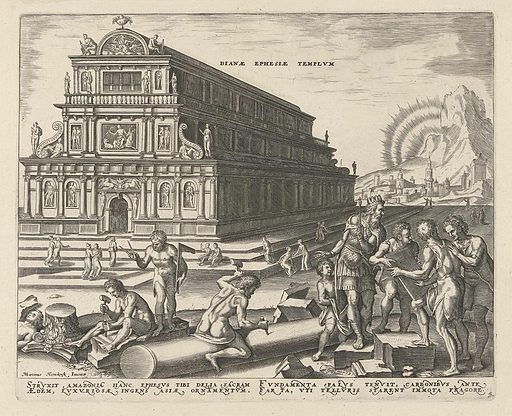

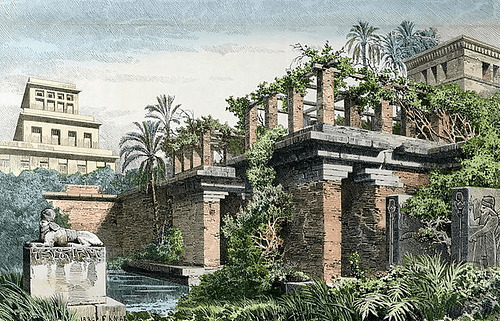
#polls#seven wonders#seven wonders of the world#colossus of rhodes#temple of artemis at ephesus#statue of zeus at olympia#mausoleum of halicarnassus#lighthouse of alexandria#hanging gardens of babylon
86 notes
·
View notes
Text
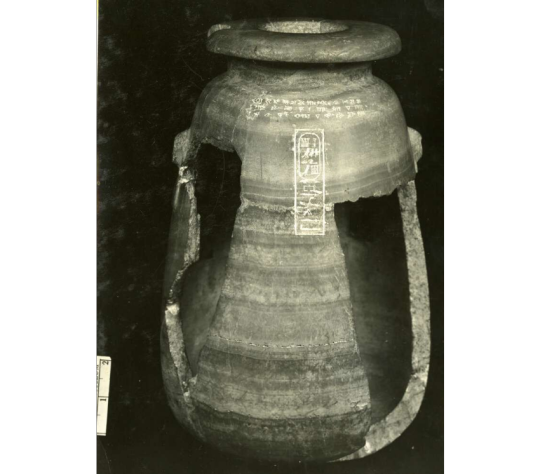
Alabaster vase from Halicarnassus with the name "Xerxes, the Great King"inscribed in three lines of cuneiform characters in the Persian, Median and Assyrian languages, and below in Egyptian hieroglyphics with a cartouche
Made in Egypt 485-465 BC. Found at the Mausoleum of Halicarnassus in
1857 by Charles Thomas Newton. [18] Translucent white and yellow-brown
calcite. Height 28.8 cm.
British Museum. Inv. No. 132114.
Source of the picture: https://www.britishmuseum.org/collection/object/W_1857-1220-1
Source of the text: http://www.my-favourite-planet.de/english/people/h1/herodotus.html
The initial description of the jar by the British Museum in 1884 refers to “Assyrian’ and ‘Median”, but it seems that the languages of the cuneiform characters of the jar are (besides of course the Old Persian) the Babylonian and the Elamite.
The function of this jar is not well known. It may have contained some of the water from the Nile, received as a symbol of submission.[1] A few other examples of broadly similar jars are known throughout the Achaemenid Empire, including jar from Darius I.[1] The jar may have been part of the collection of the Carian Satrap, and testifies to the close contacts between Carian rulers and the Achaemenid Empire.[1][3]
The vases, of Egyptian origin, were very precious to the Achaemenids, and may therefore have been offered by Xerxes to Carian rulers, and then kept as a precious object.[4] In particular, the precious jar may have been offered by Xerxes to the Carian dynast Artemisia I, who had acted with merit as his only female Admiral during the Second Persian invasion of Greece, and particularly at the Battle of Salamis.[5]
The Jar is located in the British Museum.[6] Its height is 28.8 centimetres, its diameter 12.8 centimetres at the rim.[6] It was excavated by Charles Thomas Newton in 1857.[6]
From the wikipedia article on the Xerxes’ jar (https://en.wikipedia.org/wiki/Jar_of_Xerxes_I )
15 notes
·
View notes
Text
Paul's Seven Wonders of the Modern Word - The Taco
The first seven wonders were the Seven Wonders of the Ancient World*. They were called they were: seven of them, were wonders, and were around during the times of the ancient world. Presumably there were wonders around hundreds of millions of years ago. The world back then teemed with nothing more than the odd virus colony. Unfortunately, the ancient virus never left any written record. And if…

View On WordPress
#Colossus of Rhodes#finest ingredients#Great Pyramid of Giza#hanging gardens of Babylon#Lighthouse of Alexandria#Mausoleum of Halicarnassus#of the Ancient World#of the moder world#Paul De Lancey#seven wonders#statue of Zeus at Olympia#taco#temple of Artemis#virus#written record
0 notes
Text
The Mausoleum of Halicarnassus – the first mausoleum, and known as one of the 'Seven Wonders of the Ancient World,' enthralls with its remarkable architectural design to its use of optical illusions, this ancient site is a testament to the remarkable engineering and craftsmanship of the past.
#Halicarnassus#Mausoleum#Greek#seven wonders#Turkish#reliefs#architecture#ancient#history#ancient origins
32 notes
·
View notes
Text
youtube
#mausoleum#halicarnassus#ancient wonders#ancient civilizations#ancient city#bronze age#lost temple#ancient temples#temple#dark ambient#dark academia#dark aesthetic#dark art#dark music#dark fantasy#house of the dragon#rhaenyra targaryen#aemond targaryen#house targaryen#aegon ii targaryen#daenerys targaryen#fire and blood#game of thrones#goth#gothic#goth aesthetic#Youtube
3 notes
·
View notes
Text
do you ever cry over ancient artifacts and or the wonders of the ancient world? yes or no. be honest guys.
14 notes
·
View notes
Photo

• HALICARNASSUS | Halikarnassos Slab
...came across these old pics of mine occasionally [taken MMXVIII AD, I believe], am not sure I ever posted them before so maybe it's worth [re-]posting now - just cleaned them up a bit, resized and adjusted the contrast:
Piece of the Amazonomachy Frieze of Halikarnassos [Halicarnassus] Mausoleum
https://en.wikipedia.org/wiki/Mausoleum_at_Halicarnassus
Ca 350 BC.
The British Museum | BM
Ground Floor | Room 21
https://www.britishmuseum.org
BM | @michael-svetbird phs©msp | 11|18 4300X2850 [I.]
https://www.michaelsvetbird.com
The photographed object is the collection item of BM and subject to copyrights.
[non commercial use | sorry for the watermarks].
• Added to the "Reliefs-Friezes-Slabs-Sculpture" MSP Online 📸 Gallery
👉 D-ART:
https://www.deviantart.com/svetbird1234/gallery/72510770/reliefs-friezes-slabs-sculpture
#london#thebritishmuseum#britishmuseum#halicarnassus#halikarnassos#mausoleum#halicarnassusmausoleum#marbleslab#slabs#marble#frieze#relief#ancientsculpture#sculpture#ancientart#archaeology#antiquity#mythology#greekmythology#museology#museum#museums#ancient#arthistory#amazonomachy#αμαζονομαχία#amazzonomachia#amazonomaquia#αμαζόνες#amazons
4 notes
·
View notes
Text
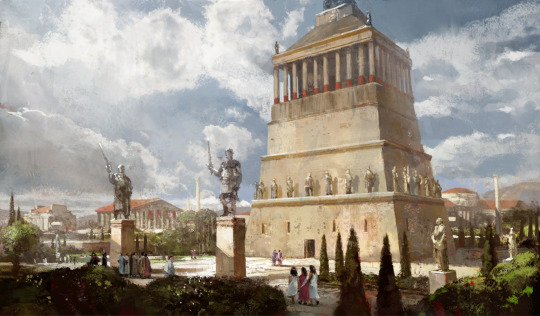
The Mausoleum at Halicarnassus
#mausoleum#halicarnassus#tomb#seven wonders of the world#seven wonders of the ancient world#ancient world#history#architecture#greek#greece#ancient#classical#monument#asia minor#mausolus#artemisia ii#caria#sculptures#statues
19 notes
·
View notes
Text
The Mausoleum at Halicarnassus
The Mausoleum at Halicarnassus is one of the seven wonders of the ancient world (a topic which I may write about in the future) and looks certifiably like a giant lego brick. That being said though, at least it’s a cool lego brick. Here’s a reconstruction of the building at its height:
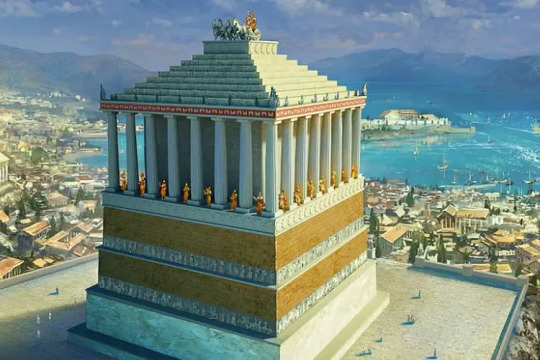
This building was dedicated to Mausolus, a satrap of the Achaemenid Empire (also known as the Persian Empire), and placed in Halicarnassus. For those who aren’t aware, this building no longer stands, probably due to an earthquake sometime after the 10th century CE: we can’t really narrow it down much more. Here's the site now:
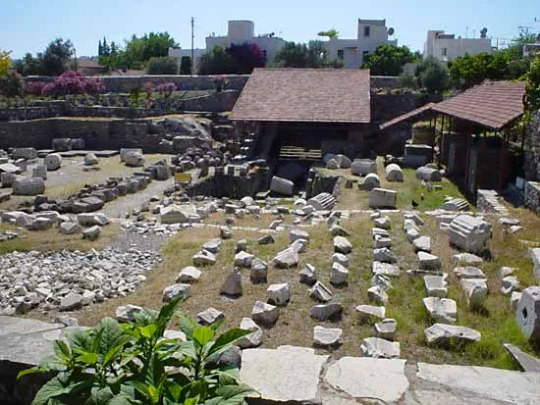
It was described in detail by Pliny the Elder in his book Natural History, and its scale when recreated is both shocking and frankly awesome. It would have towered above the city, and it’s well worth considering it a wonder. It’s worth mentioning that this was built by a Greek to honor a Persian in the time between the Persian Wars and Alexander’s conquests, and this period is often neglected because white men have trouble romanticizing a period of at least somewhat stable, yet contentious, peace.

That aside, this period saw huge megastructures built like this in Anatolian Greek cities like Halicarnassus, Pergamon, and others. It was mainly to show off wealth, but many of these cities had a relationship with Persia that can be described as “independence guaranteed,” by Persia. The political declarations and letters of this era are really interesting but obscure enough that finding them in any books is difficult at best. But, regardless of the lack of study, the grandeur of this giant lego brick speaks for itself.

Also, this is where the word mausoleum comes from, it appears. Next time you say that word, send some thanks to Mausolus who had his body interred in a structure that is now just a common English word. It’s pretty neat. Linguistics is neat.
Thanks for reading.
#history#architecture#ancient history#ancient literature#ancient greece#greece#greek history#mausoleum at halicarnassus
2 notes
·
View notes
Video
youtube
All 13 wonders I built in The Head of Cyrus Challenge in the order they ...
#youtube#civilization 6#monthly challenge#wonders#pyramids#hanging gardens#apadana#petra#colossus#taj mahal#alhambra#great lighthouse#mausoleum at halicarnassus#kilwa kisiwani#angkor wat#etemenanki
1 note
·
View note
Text
7 Wonders of BL
1 Colossus of Rhodes MaxTul

2 Great Pyramid of Giza Thailand

3 Hanging Gardens of Babylon BL

(what, like I’d let that one slide, whatcha take me for?)
4 Statue of Zeus at Olympia Bangkok

5 Temple of Artemis at Ephesus Taipei


6 Mausoleum at Halicarnassus GMMTV

7 Lighthouse of Alexandria Vietnam

Some of you will get the jokes... some of you will only get the thirst.
That’s okay too.
Before you ask, here’s the pulls:
Together with Me
Manner of Death
KinnPorsche
Step by Step
Love is Science?
He’s Coming To Me
Mr Cinderella
(source)
#thai bl#vietnamese bl#taiwanese bl#7 wonders of bl#Together with Me#MaxTul#Manner of Death#Great Sapol#KinnPorsche#VegasPete#Step by Step the series#man trisanu#Love is Science?#Mark Ouwen#Lin Yu#He’s Coming To Me#Mr Cinderella#Bah Vinh#random thirst post#i wonder if tumblr will even serve this one?
416 notes
·
View notes
Text
Time Travel Question 18: Ancient History VIII and Earlier
These Questions are the result of suggestions from the previous iteration.
This category may include suggestions made too late to fall into the correct grouping.
Please add new suggestions below if you have them for future consideration.
#Bering Straight Land Bridge#Ancient Israel#Stempunk#Ancient Egypt#Alexandria#Automata#Time Travel#Paleolithic#Neolithic#Domestication#History of Food#Gaul#The Temple of Artemis#Ancient World#Olympia#Halicarnassus#Malaysia
66 notes
·
View notes
Photo
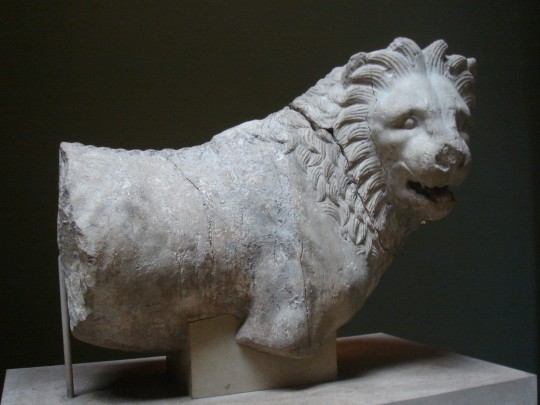
Halicarnassus
Halicarnassus (modern Bodrum, Turkey) was an ancient Ionian Greek city in the region of Caria, located on the coast of Anatolia. It is best known as the birthplace of Herodotus (l. c. 484-425/413 BCE), the 'Father of History', and as the site of the Mausoleum at Halicarnassus, one of the Seven Wonders of the Ancient World.
Continue reading...
72 notes
·
View notes
Note
How was your holiday?
Thank you for asking! Forgive me, but I'm going to answer in great detail. :'D
First I spent 10 days on the coast of Aegean Sea in Turkey and it was great! Turkey is beautiful and there's a lot to explore. I visited the site of the Halicarnassus Mausoleum (which is considered one of the Seven Wonders), the Bodrum Castle, the Museum of Underwater Archeology. Spent quite some time on the beach (lots of fresh orange juice consumed, two books finished) and swam until my lips turned blue. Went on foot to nearby bays/towns just because it's fun to walk. Dined by the sea.
We only had wifi in the hotel lobby (which was 4 flights of stairs down from our cottage), and it was ultimately a good thing to stay off the phone.
And then I spent about a week in Moscow where I saw family and friends, many of whom were visiting the city and it was great luck to coincide like that. I went to the Book Museum in the Russian State Library, Architecture Museum (awesome exhibition on Falсonnier!) and the Apothecary Garden and their greenhouses and rose exhibition. We also explored VDNKh (so many roses!), ate draniki in the Belarus Pavillion and had a dessert of walnut pastries and apricot juice in the Armenia Pavillion. I wanted to go to the 100 Years of Soviet Animation exhibition but unfortunately it was closed that day. I also saw Don't Be Afraid, I'm With You with a group of friends, it's a big musical based on songs of Secret, a Russian band I love very much, and it was absolutely magnificent.
61 notes
·
View notes
Photo
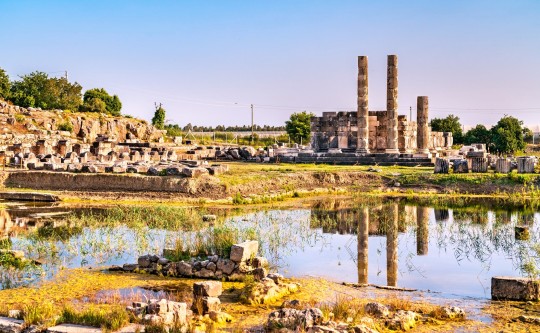
Ancient Letoon - the first temple to the Goddess Leto and Her children in the city of Xanthos (sometimes: Xanthos-Letoon; Lycian: 𐊀𐊕𐊑𐊏𐊀 Arñna) located in the southwestern part of Anatolia, Turkey. The complex represents extant examples of the Ancient Lycian civilization, one of the most important cultures of the Anatolian Iron Age.
Xanthos was the capital of Ancient Lycia (Lycian: 𐊗𐊕𐊐𐊎𐊆𐊖 Trm̃mis), and the ruins of the site still demonstrate how pre-Greek Lycian traditions blended with Hellenic and Roman influence overtime. Some of the Lycian monuments include: the Lycian Acropolis, heavily remodeled after the Hellenistic and Byzantine eras; great funerary monuments and examples of Xanthos-typical woodwork are featured in the area as well. A later archaeological zone is present in Xanthos, too, with the Hellenistic Acropolis alongside the Roman and Hellenistic agoras and some later-constructed churches.
One of the most spectacular buildings at the site, though, are temples to Leto, Artemis, and Apollo dating back to the 6th century BCE, which means that the site predates Hellenic influence in the region as well as prominence of Leto in Greece, where the cult came in the 4th century BCE. That, together with Leto’s name of uncertain etymology, might suggest that the Goddess has a precursor - an Anatolian Mother-Goddess, possibly the local Eni Mahanahi. The cult of the local Mother-Goddess included a variety of functions, such as observation of funeral rites.
Later buildings erected at the site date back to different time periods in the political history of Lycia, which includes a Hadrian era Nymphaeum.
According to UNESCO, the Halicarnassus Mausoleum, one of the Seven Wonders of the Ancients, is directly influenced by Xanthos’ Nereid Monument:

Sources and further reading: 🏺 🏺 🏺
#HISTORIA 📔#ancient anatolia#ancient greece#ancient rome#ancient lycia#anatolian gods#greek gods#roman gods#leto
97 notes
·
View notes
Photo


The Heptagram of the Seven DaysThe Heptagram of the Seven days is a particularly interesting way to view the order of the celestial bodies. If reading clockwise from the top-most symbol, it is the order of the planets from the Geo-centric Qabalistic model: Saturn, Jupiter, Mars, Sol, Venus, Mercury, Luna. If read following the lines of the Heptagram, one gets the days of the week: Saturday (Saturn’s Day), Sunday (Sun’s Day), Monday (Moon’s Day), Tuesday (Tiw’s Day, Norse War God), Wednesday (Wodin’s Day), Thursday (Thor’s Day), Friday (Frigga’s Day, Norse Love God.) Crowley attributes this realization to Frater Deo Duce Comite Ferro, S.L. MacGregor Mathers. This is one of two different kinds of Heptagrams. This version is known as 7/3 Heptagram, as each line connects the planet that is three planets away. The other version of the Heptagram is called a 7/2 Heptagram, and is used for the Seal of A∴A∴.
DANCE OF THE SEVEN VEILS
“The seven spheres attached to the seven planets symbolize seven principles, seven different states of matter and spirit, seven different worlds which each man and each humanity must pass through in their evolution across a solar system.” – The Wisdom of Egypt7 the sum of my name YOSRA HARZALLAH7 Daughters of Atlas7 Stages of Alchemy - Calcination, Dissolution, Separation, Conjunction, Fermentation, Distillation, Coagulation.7 Hermetic principles - Mentalism, Correspondence, Vibration, Polarity, Rhythm, Cause and Effect, Gender.7 Notes of the musical scale.7 Systems of Symbolism - numbers, geometrical figures, letters, words, magic, alchemy, astrology.7 Rays of Light - Red, Orange, Yellow, Green, Blue, Purple, Violet.7 Planets of Antiquity - Moon, Mercury, Venus, Sun, Mars, Jupiter, and Saturn.7 Churches of Asia Minor7 Personality Types - Lunar, Mercurial, Venusian, Solar, Martial, Jovial, Saturnine.7 Days of Week - Sunday, Monday, Tuesday, Wednesday, Thursday, Friday, Saturday.7 Arch Angels - Michael, Gabriel, Raphael, Uriel, Chamuel, Jophiel, and Zadkiel.7 Metals of Antiquity - Lead, Tin, Iron, Copper, Mercury, Silver, Gold.7 Chakras - Muladhara, Svadhisthana, Manipura, Anahata, Vishuddha, Ajna, Sahasrara.7 Emotive Spheres of Kabbalah7 Seals.7 Root Races, each with 7 sub-races7 Days of Creation7 Virtues - Faith, Hope, Charity, Fortitude, Justice, Prudence, Temperance.7 Vices - Pride, Envy, Anger, Sloth/dejection, Avarice, Gluttony, Lust.7 Stages of Man - the infant, the school-boy, the lover, the soldier, the judge, the elderly man, the senile one.7 Liberal Arts - grammar, rhetoric, logic, arithmetic, music, geometry, and astronomy - the first three in the Trivium, the latter four in the Quadrivium.7 Wonders of the Ancient World - Pyramids of Egypt, Hanging Gardens of Babylon, Statue of Zeus at Olympia, Temple of Artemis at Ephesus, Mausoleum of King Mausolus at Halicarnassus, Colossus of Rhodes, Pharos Lighthouse at Alexandria.7 Headed Hydra7 Headed Lion7 Headed Dragon7 Headed Serpent7 Seas - Arctic, Antarctic, North and South Pacific, North and South Atlantic and the Indian Ocean.7 Continents - North America, South America, Africa, Europe, Asia, Australia and Antarctica.7 Seven Sisters of the Pleiades star system.7 Parts to the embryo - Amnion, Chorionic Villi, Spinal Cord, Heart, Brain, Umbilical Cord, Yolk Sac.7 Parts of the body - Head, Thorax, Abdomen, Two Arms, Two Legs.7 Major Organs - Brain, Heart, Lungs, Stomach, Intestines, Liver, and Pancreas.7 Glands - Pineal, Pituitary, Thyroid, Thymus, Adrenal, Lyden and Gonad.7 Divisions to the brain - Cerebrum, Cerebellum, Pons Varolii, Medulla Oblongatta, Corpus Callosum, Spinal Cord, Meninges.7 Parts to the inner ear - Vestibule, Auditory Canal, Tympanic Membrane, Ossicles, Semi-circular Canal, Cochlea, Membranous Labyrinth.7 Parts to the retina - Cornea, Aqueous Humor, Lens, Vitreous Humor, Retina, Sclera, Iris.7 Cavities to the heart - Right and Left Ventricle, Right and Left Atrium, Tricuspid Valve, Mitral Valve, Septum.7 Body systems - Muscular, Skeletal, Nervous, Digestive, Respiratory, Excretory, Circulatory.7 Bodily functions - Respiration, Circulation, Assimilation, Excretion, Reproduction, Sensation, Reaction.7 Levels in the Periodic Table of the Elements.…and, of course, the 7 Dwarfs.“The Principles of Truth are Seven; he who knows these, understandingly, possesses the Magic Key before whose touch all the Doors of the Temple fly open.” –The Kybalion“And God created seven Heavens and seven Earths, and through them all, descends His Command.” – scriptural translation
197 notes
·
View notes